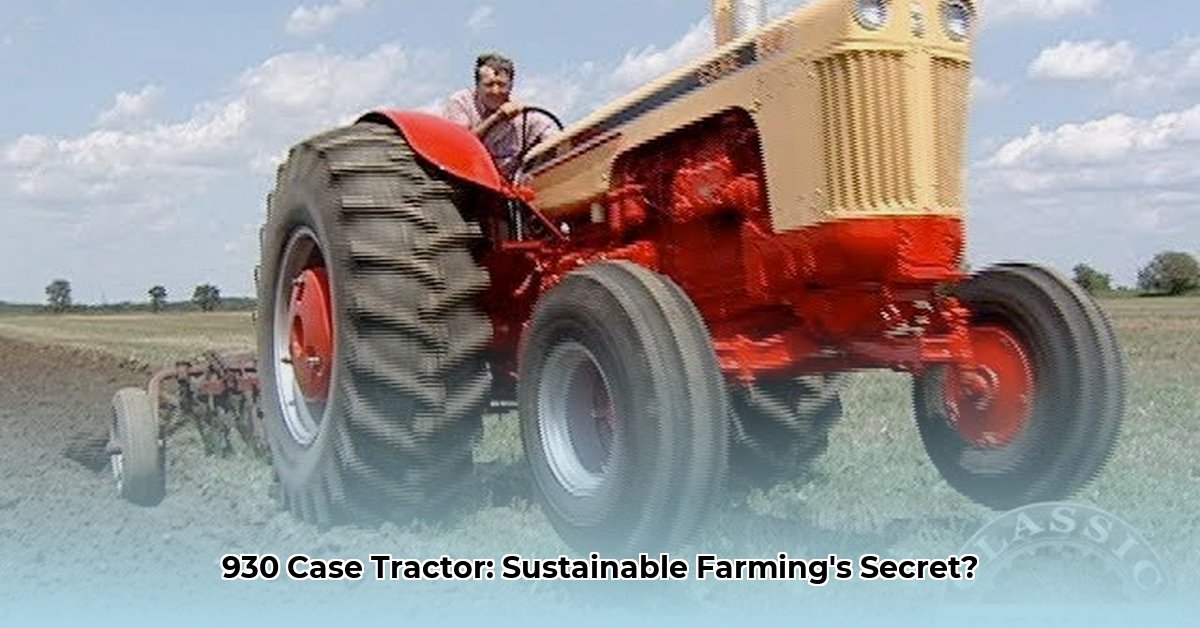
The J.I. Case 930 tractor, a stalwart of 1960s agriculture, embodies a pivotal moment in farming's mechanization. This article examines its specifications, placing them within the historical context of the era and assessing its legacy through a modern lens of sustainable farming practices. We will explore what we know—and crucially, what we don't know—about its environmental impact. For more Case tractor models, check out this useful resource.
Decoding the 930's Vital Statistics: A Puzzle of Incomplete Data
Precise specifications for the Case 930 prove elusive, owing to the age of the machine and variations in record-keeping methodologies. Different sources offer conflicting figures, particularly regarding horsepower. Is this discrepancy a result of differing measurement techniques, or simply incomplete documentation? This uncertainty underscores the challenges of evaluating older technology through a modern sustainability framework.
Here's a summary of the available data, highlighting the crucial gaps:
| Specification | Value (Source A) | Value (Source B) | Notes |
|---|---|---|---|
| Engine Size | Not specified | Not specified | A critical omission hindering accurate fuel consumption estimations. |
| Horsepower (Belt HP) | 83 | N/A | Manufacturer's estimate; likely differs from PTO HP. |
| Horsepower (PTO HP) | N/A | 80.6 | PTO horsepower – power available to operate farm implements. |
| Fuel Capacity | Not specified | Not specified | Essential for determining fuel efficiency and overall environmental impact calculations. |
| Transmission Type | Not specified | Not specified | Transmission type significantly impacts operational efficiency and fuel consumption. |
This incomplete dataset severely limits our ability to definitively assess the 930's environmental impact. How can we truly understand its fuel efficiency without knowing its engine size and fuel tank capacity? This lack of data highlights the need for more comprehensive historical records of agricultural machinery.
Farming in the Sixties: A "More is Better" Mentality
The agricultural landscape of the 1960s prioritized maximizing yields above all else. Mechanization was accelerating, and tractors like the 930 played a key role in this intensification. Its increased horsepower, compared to previous models, allowed farmers to cultivate larger areas and achieve greater harvests. But did this come at a cost? The long-term environmental implications of this "more is better" approach, including soil compaction and chemical runoff, were largely unappreciated at the time. The 930, reflective of its era, was a tool of this paradigm.
Sustainability: The Missing Pieces of the Puzzle
Assessing the 930's environmental footprint requires answering several crucial questions, answers that are presently unavailable. Without this data, any conclusions about its sustainability remain speculative. The absence of information leaves us with a critical gap in our understanding. Key questions to address include:
- Fuel Consumption: How much fuel did the 930 consume per acre worked? This metric is essential for evaluating its energy efficiency.
- Maintenance and Repair: What were the frequency and environmental impact of its repairs, considering both material usage and waste generation?
- Lifespan and Disposal: What was the typical lifespan of the 930, and what were the methods and consequences of its disposal?
- Soil Compaction: How did the 930's significant weight impact soil compaction, a major concern for sustainable agriculture today?
This lack of crucial data prevents a complete assessment. Further research is needed to fill these knowledge gaps.
Then and Now: Bridging the Technological Divide
Comparing the 930 to modern tractors is challenging due to the data limitations. It's highly probable that modern tractors, designed with sustainability in mind, exhibit vastly improved fuel efficiency and reduced emissions. They also incorporate technologies minimizing soil compaction. However, without precise data on the 930's performance, a quantitative comparison remains impossible. This underlines the importance of comprehensive data collection for future technology evaluations.
Lessons from the Past: A Call for Sustainable Practices
The incomplete data surrounding the Case 930 serves as a valuable lesson. It underscores the need for meticulous record-keeping and the critical importance of integrating environmental considerations into the design and operation of agricultural machinery from the outset, not as an afterthought. The incomplete story of the 930 serves as both a historical artifact and a potent reminder of the ongoing need to improve sustainable practices in agriculture. Its legacy should drive us to improve data collection and analysis for a more environmentally responsible future in agriculture.
Key Takeaways:
- The J.I. Case 930's specifications, while incomplete, reflect the agricultural priorities of the 1960s.
- A lack of data significantly hinders the accurate assessment of its environmental impact.
- Understanding the 930's limitations highlights the need for more comprehensive data collection and a broader consideration of sustainability in agricultural technology.
- Future research should prioritize filling the data gaps to fully evaluate the 930's historical significance.